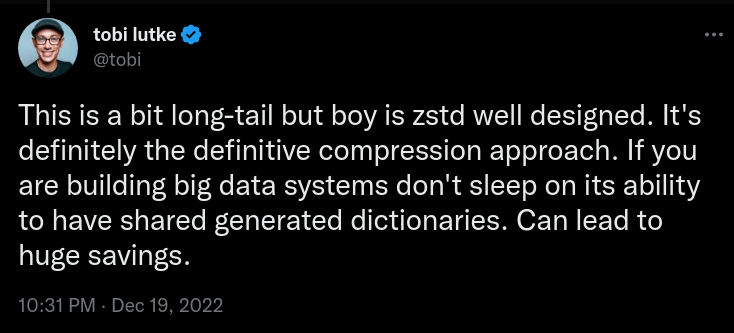TIL - zstd
I was going through Tobi’s list of some really cool programming tech and got curious about zstd.

Zstandard (also known as zstd) is a Fast real-time compression algorithm from Facebook.
What is zstd ?
- zstd is a “lossless” data compression algorithm
- Lossless means
- it can compress data without losing any of the original information.
- it restores and rebuilds the data in its original form, after decompression.
- Lossy compression does not do that.
- Lossless means
How zstd works
- Zstd starts by analyzing the data to be compressed and identifying patterns and redundancies within the data.
- Zstd divides the data into small blocks.
- It then encodes the data using a combination of techniques, including Huffman coding and run-length encoding.
- Huffman coding represents symbols using fewer bits based on their frequency of occurrence in the data.
- Run-length encoding is a method of representing runs of repeated characters using a single character and a count.
- Finding patterns that can be represented more efficiently. It then replaces these patterns with shorter representations, resulting in a smaller overall size of the data.
- Zstd also includes a dictionary-based compression method, allowing it to reference a pre-defined set of commonly used strings and patterns to compress the data more effectively.
- For example, if the word “the” appears many times in the data, it could be replaced with a single symbol instead of spelling out the whole word each time.
- The compressed data is then output in the form of a zstd compressed file, which a zstd decompressor can decompress to retrieve the original data.
It’s really neat!
Benefits
- It is very fast both when compressing and decompressing
- It is very efficient, achieving good compression ratios with relatively low computational overhead.
(And I asked ChatGPT to explain me 3 times. I am super impressed wow)